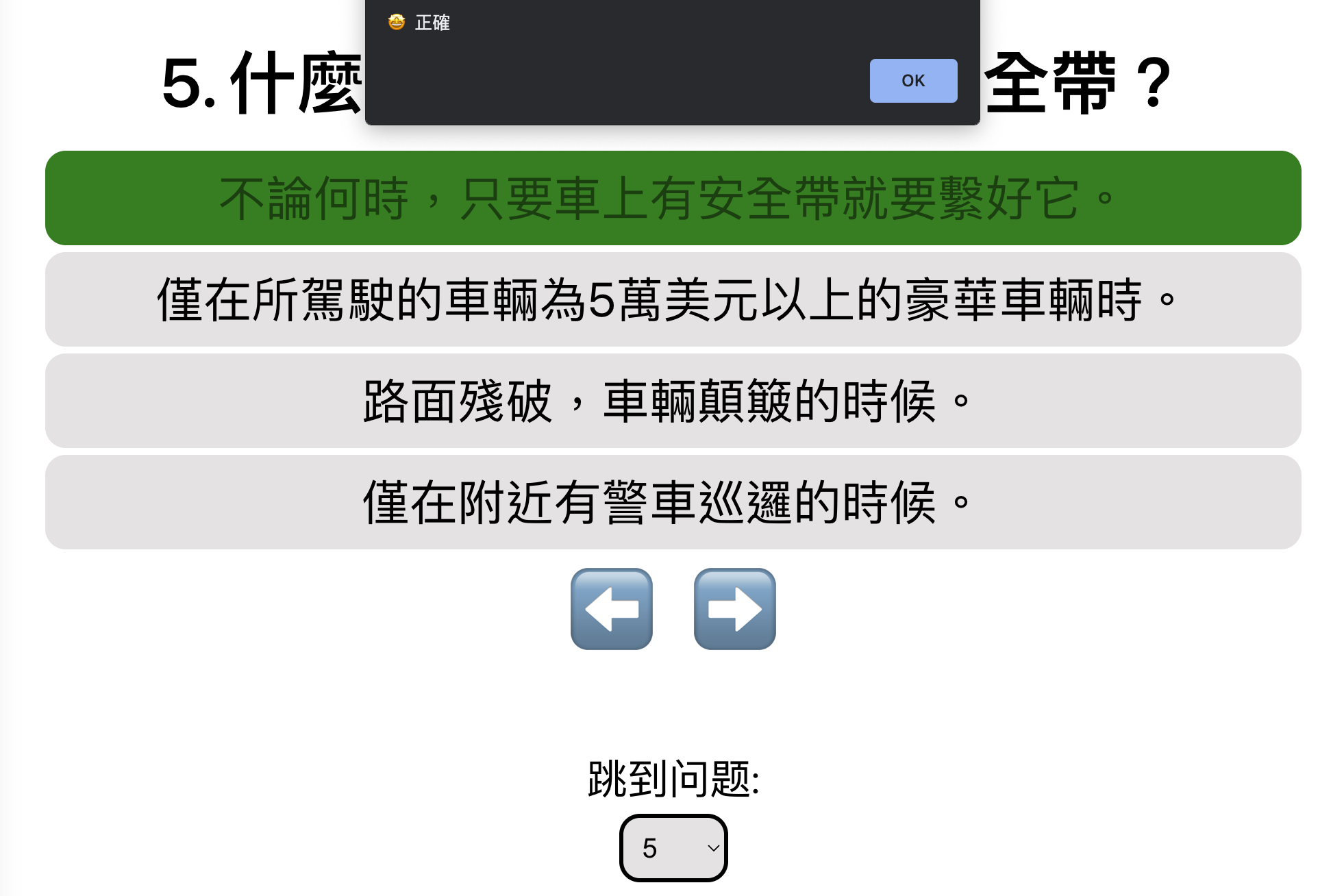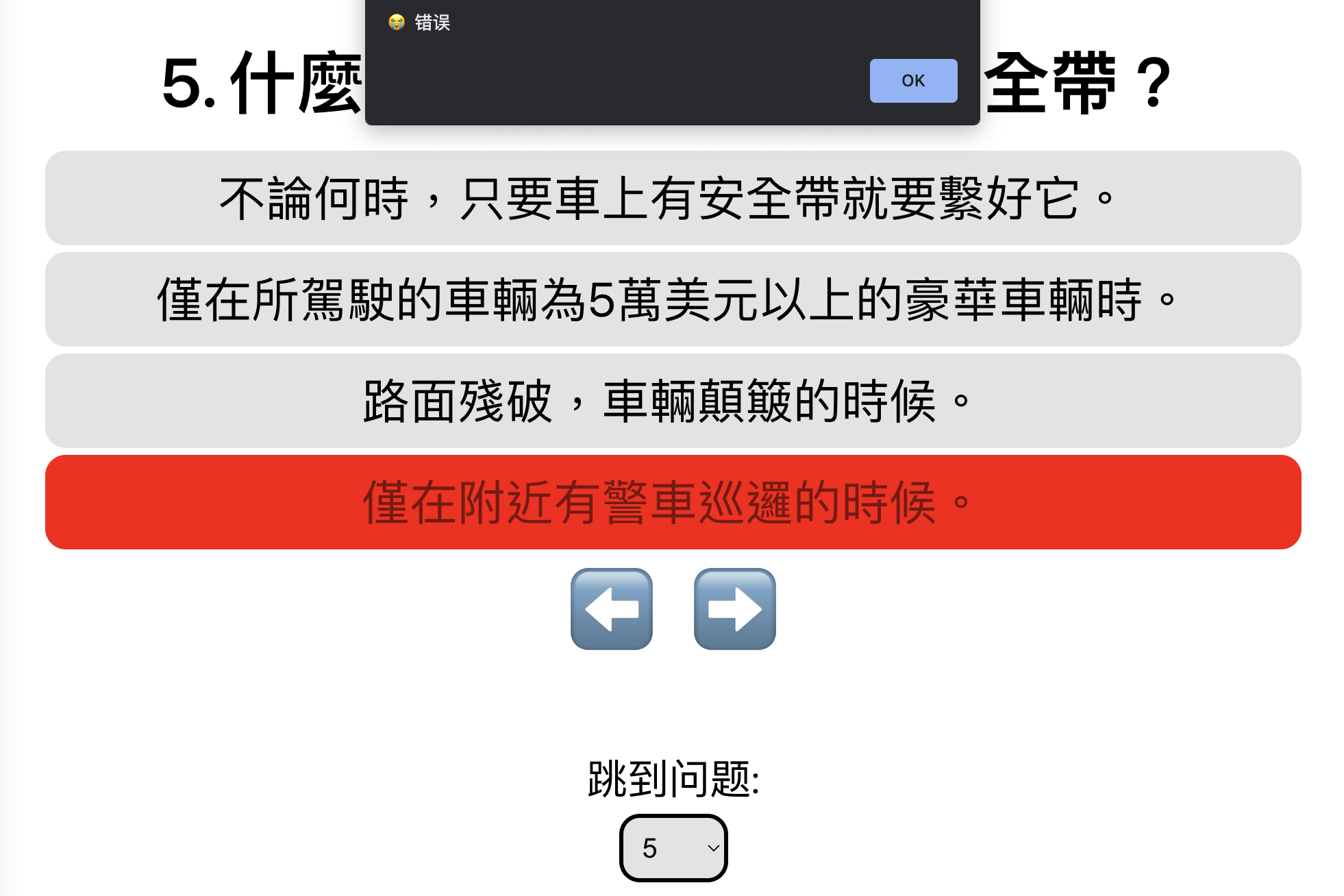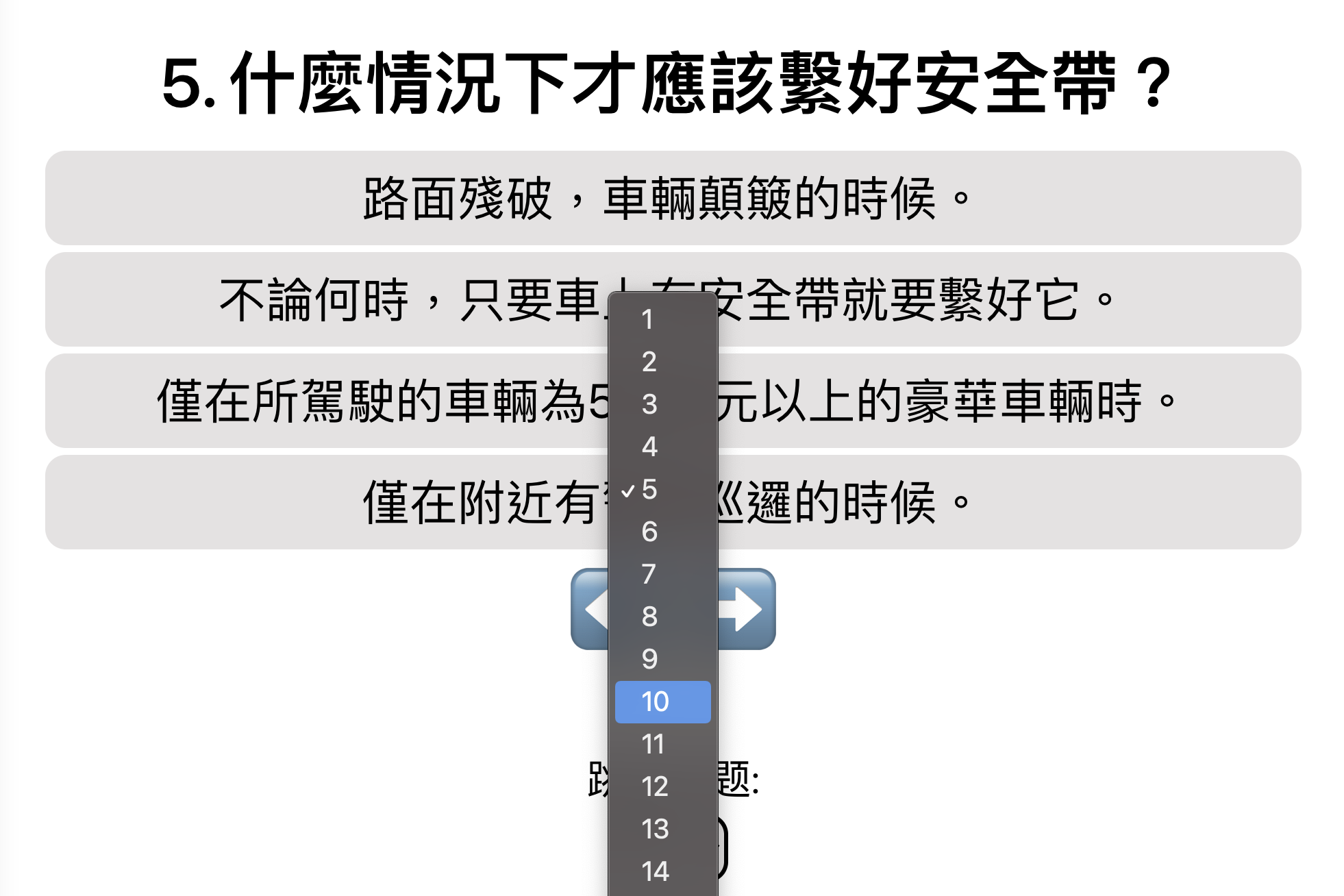Chinese DMV Practice Exam
Overview
Problem Statement
Over the summer, my grandma wanted to study for the exam, but she couldn’t find any official practice questions in Chinese. Currently, the California DMV website only offers practice knowledge tests in English, Spanish, and ASL. While I found a Chinese website with practice permit test questions, my grandma was frustrated with the site because she kept clicking on extraneous pop-ups and links.
Solution
As I wanted to both help my grandma and learn how to use React, I developed and designed a React app that allowed my grandma to study the scraped practice questions on an intuitive interface. I also sought feedback from my family and grandma to understand which additional features and enhancements would best facilitate her learning. She passed the test a few weeks later!
Data Collection
Scraping
On the website with Chinese practice questions, each page consists of one question. I wrote a Python function scrape_q() that takes in a question number as input and uses the BeautifulSoup library to scrape the question title, correct option, and incorrect options. In a separate function, the returned data is then appended to the three respective columns in a pandas DataFrame. After extracting each question from the site, the DataFrame is written out to a JSON file. Honestly, I don’t know why I didn’t create a list of dictionaries and convert it using json.dumps, but I guess I wanted to feel like a data scientist by using pandas.
Code snippet of adding each question’s data to the DataFrame and then writing it to a JSON file.
df = pd.DataFrame(columns=["q", "c", "w"])
total_qs = 300
for q_num in range(0, total_qs):
q_elts = scrape_q(q_num+1)
if q_elts:
q_title, q_correct, q_wrong = q_elts
df = df.append({"q": q_title, "c": q_correct, "w": q_wrong}, ignore_index=True)
with open(filename, 'w', encoding='utf-8') as outfile:
df.to_json(outfile, force_ascii=False, orient="records")Data Format
In the JSON file, each question is formatted as shown below. The q key stores the question’s title, c stores the correct answer, and w stores the wrong answers.
{
"q": "如果你駕車時經過一片施工區域,應該怎麼做才對?",
"c": "集中精神,小心駕駛即可。",
"w": [
"減速,小心路上的工人。",
"鳴笛,引起周圍行人和車輛的注意。",
"加速通過,以免影響工人施工。"
]
},Design & Features
Minimalistic Design
As my grandma would be the app’s primary user, the interface needed to be straightforward to use and simple in its design. Each page displays one question at a time, along with four answer options.
Correctness Indicators
I used a <TouchableHighlight> React component, which reveals the button’s underlying color upon pressing it. After making a selection, the button color changes to green or red, which corresponds to a correct or incorrect answer, respectively. In addition, an alert will appear and display a message that indicates the correctness of the selection. To congratulate my grandma on finishing the entire practice test, the last question has a special alert message just for her!


Code snippet of generating
{options.map((option, index) => (
<TouchableHighlight
key={"option-" + index}
style={styles.button}
onPress={() => choose(option.isCorrect)}
activeOpacity={0.5}
underlayColor={(option.isCorrect) ? "green" : "red"}>
<Text style={styles.text}>
{option.answer}
</Text>
</TouchableHighlight>
))}Navigating Questions
Below the question, the large arrows allow users to view the previous or next questions. In addition, the exact question number can be selected from the dropdown list. I wrote back(), forward(), and skip() navigation functions to enable these features. Also, I used a State Hook to preserve the current state (or the question number variable), which corresponds to its index in the imported data. This allows for ease of subsequent renders upon changing the current state in the navigation functions.
Code snippet of useState Hook usage and navigation functions.
const [current, setCurrent] = useState(0);
const back = () => {
const last = current - 1;
if (last >= 0) {
setCurrent(last);
}
};
const forward = () => {
const next = current + 1;
if (next < data.length) {
setCurrent(next);
}
};
const skip = (event) => {
let questionNum = event.target.value;
setCurrent(questionNum - 1);
};Randomizing Answer Options
Upon returning to a specific question, the options are randomly shuffled. This was achieved using the Fisher-Yates Shuffle algorithm, which I Googled and copy-pasted from this Stack Overflow post like a true software engineer (obviously).
Personal Reflection
Challenges
- Learning how to use React
- Designing the UI
- Figuring out how to change the color of a damn button 🥲
Future Improvements
- Fixing the button color on click: the colors don’t change in certain cases on the computer, and it completely doesn’t work on phones and tablets
- Including questions with images: I may have filtered out questions with pictures because I didn’t want to deal with them 🤷🏻♀️
- Scraping questions from other sources: currently all the questions are solely from the sketchy Chinese website
- Documentation: I initially wasn’t thinking about uploading this project to GitHub until several months later after the test was over… but to be honest, I’m too lazy to go back and document my code… 😅
Takeaways
Overall, I enjoyed working on this project, and it was so rewarding to help my grandma pass her test! Furthermore, I’m grateful for the opportunity to put my computer science degree to use after graduating and improve upon my programming skills, though my documentation (or lack thereof) could use some work. This project gave me a good introduction to React, and I hope to make web apps with more complicated components in the future!
Usage
To run this app locally, follow the steps below!
-
Clone this repository.
git clone https://github.com/peyton-a-wang/chinese-practice-dmv-test.git -
Install project dependencies from the root directory.
cd chinese-practice-dmv-test npm install -
Run the app in development mode and view it in the browser.
npm start
Optional: The questions are already included in the repo, but if you want to run the scraper script, you need to install the scraper dependencies first, which I highly recommend installing in a virtual environment. Then, run the script to scrape the questions from the website (it takes around 30s to collect all the data) and write them into the JSON file.
python3 -m venv venv
. venv/bin/activate
pip3 install -r src/scrape/requirements.txt
python3 src/scrape/scrape_questions.pyTechnology & Tools
Languages & Libraries
References
create-react-app: create React app from scratch- followed steps in deployment guide
gh-pages: publish app files to GitHub pages

